Best
AFFORDABLE ELECTRONIC DRUM KIT
-
Overall: A complete electronic drum set with mesh heads, MIDI over USB, and integrated practice tools
-
Best Feature: The Turbo Mesh Kit's 8" mesh snare and toms transition naturally
-
TedScore™: 9/10
Best OVERALL
ELECTRONIC DRUM
KIT
-
Overall: World-class set of pads and a newly enhanced TD-27 sound module
-
Best Feature: Deep editing capabilities allow you to tune, tinker, and tweak every facet of your tone
-
TedScore™: 8.9/10
Best
BEGINNER
ELECTRONIC
DRUM KIT
LOOKING FOR
PLENTY OF FEATURES
-
Overall:
Dual Zone Trigger On The Snare -
Best Feature:
Complete Kit -
TedScore™:
8/10
As a musician in the modern era, you’re likely familiar with the sweet ambient noise acoustic drums provide.
Yet you also hear that the electronic drums offer a new rhythm to explore, merging technology with tradition.
So, what are the pros and cons of electronic drums?
You may be deciding whether to buy an electronic drum kit, yet you don’t know if it’s better than an acoustic drum set. Then, you try to gather information online to help you decide, but it seems difficult to reach a consensus.
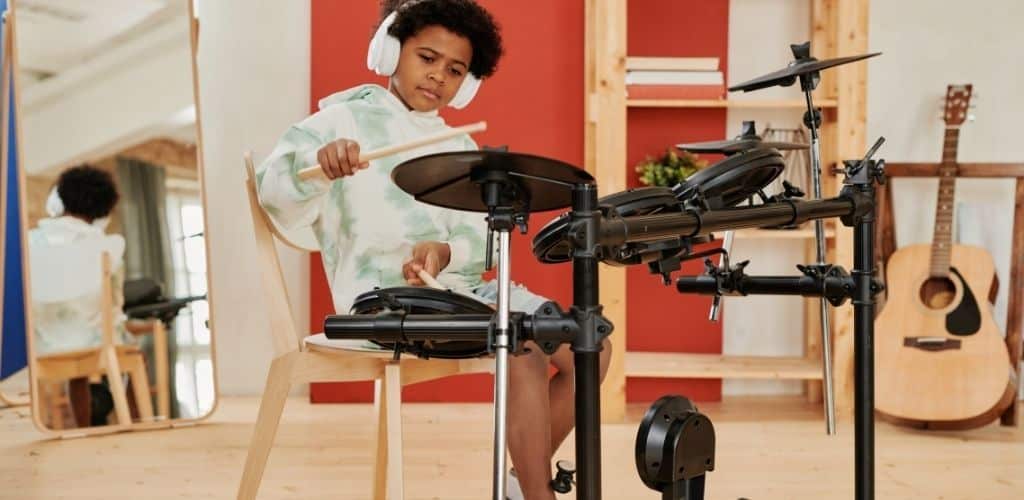
Don’t fret, my friend! I got you! I’ll share my professional take on the pros and cons of electronic drum kits, so read on!
Most electronic drum kits bring many advantages, like the bliss of playing without irking the neighbors, thanks to volume control.
Switching between sounds and kits is as simple as tapping a button, expanding your creative palette.
But it’s not all high notes; there can be trade-offs.
They might not mimic the exact feel of their acoustic siblings, which can be a sticking point for purists (ones who stick to the traditional drum kits!).
But let’s dig in deep!
Fundamentals of
Electronic Drums
Electronic drums revolutionized how you play music, blending traditional percussion techniques with modern technology.
Technology and Components

Your electronic drum kit is anchored by the drum module, a magical box that serves as the brain. It processes your inputs and determines the sound from the speakers.
Think of the sound module as an extensive sound library, holding a treasure trove of sounds—from snappy snares to booming bass drums. It’s where you can find whatever tone tickles your fancy.
With a USB/MIDI connection, your drum kit becomes a musical chameleon. It integrates computers and recording equipment seamlessly, turning your kit into a studio powerhouse.
Every strike you make can be captured, quantized, and manipulated, giving you full control over your musical creations.
Variety of Sounds and Kits
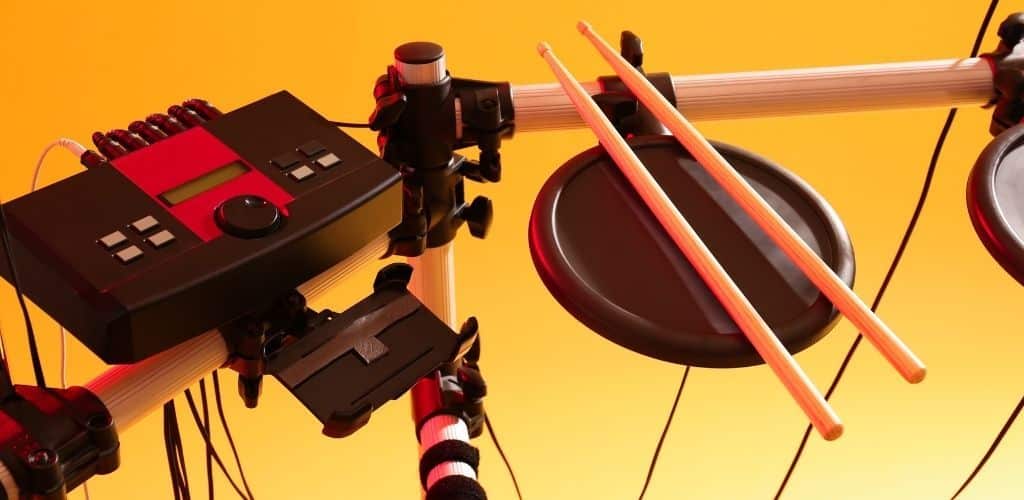
Picture an acoustic drum kit; it has a fixed sound depending on its construction.
But your electronic kit?
It’s a kaleidoscope of sounds!
With just a few taps, you can switch between rock, jazz, or electro soundscapes.
Electronic kits really shine in dynamic control.
Whether you’re lightly tapping for a whisper-quiet beat or giving it your all for that earth-shattering crash, the pads’ sensitivity captures every nuance of your technique.
It’s all about the feel and the flow, allowing you to express yourself in volumes and velocities.
Advantages of
Electronic Drum Kits
Electronic drums are a game-changer for your drumming journey. They offer crisp sound quality and the versatility that makes every beat an adventure.
Let’s explore how they can jazz up your music-making experience.
Portability and Space Saving
Think about not having to book an extra van to haul your drum set.
Electronic drum kits, with their nifty, compact design, are your ticket to the hassle-free life of a traveling musician.
They pack down to a size that won’t compromise your living space or test your patience when setting up for a gig.
I love how portable they are!
Volume Control and Noise Reduction
Have you ever noticed how your neighbors don’t share your passion for late-night drum solos?
With electronic drums, you can keep your groove on without sparking a neighborhood revolt!
You have volume control at your fingertips, so practice can happen at any hour without noise complaints ruining your vibe.
Recording and Connectivity
Imagine capturing your every drum fill and roll with studio-like precision at home.
Thanks to USB and MIDI connectivity, your electronic drum kit can feed directly into recording software, making it easy to lay down tracks.
This tech-savvy set-up lets you experiment and grow as a musician without needing an array of expensive recording equipment!
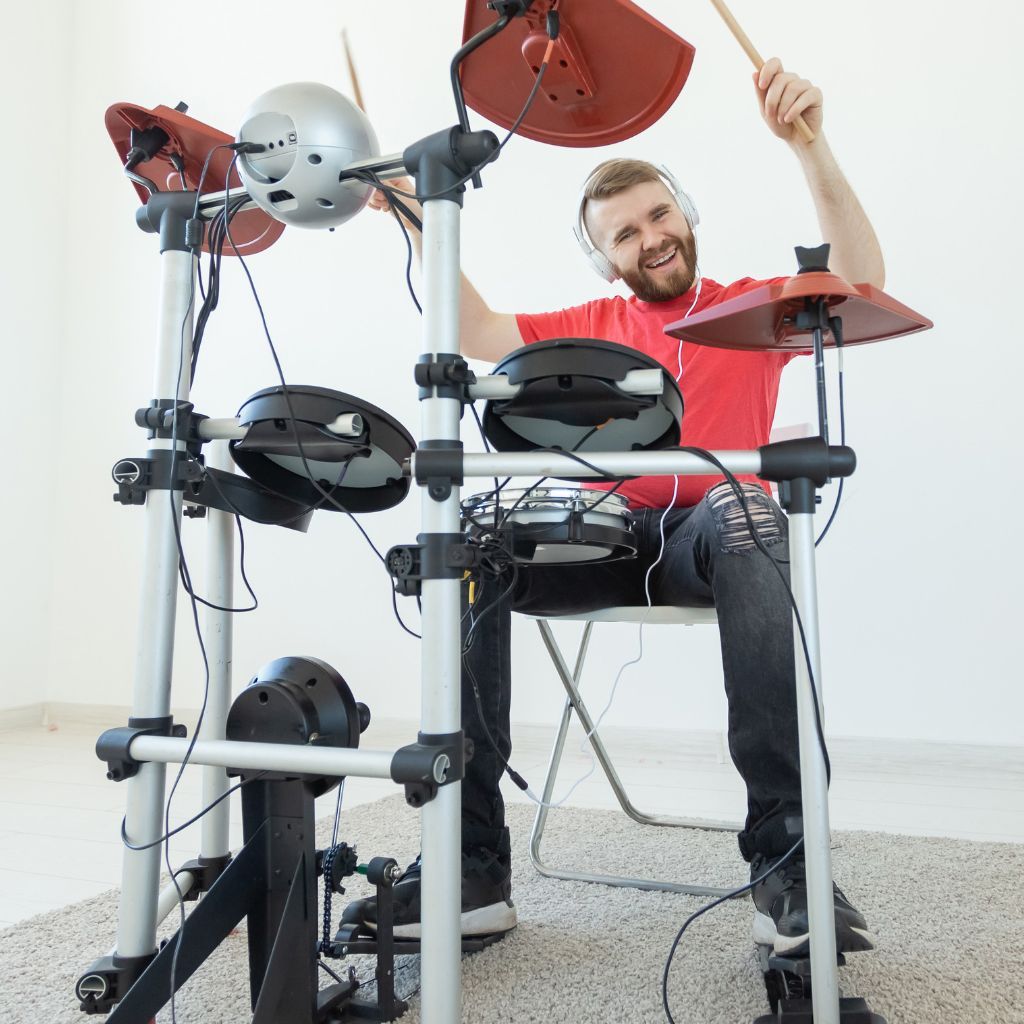
Comparing Acoustic Drums and Electronic Drums
It’s acoustic vs electronic drums when you’re stuck between wanting a rock kit and a hi-tech place.
Let’s groove into their differences!
Volume and Sound Control
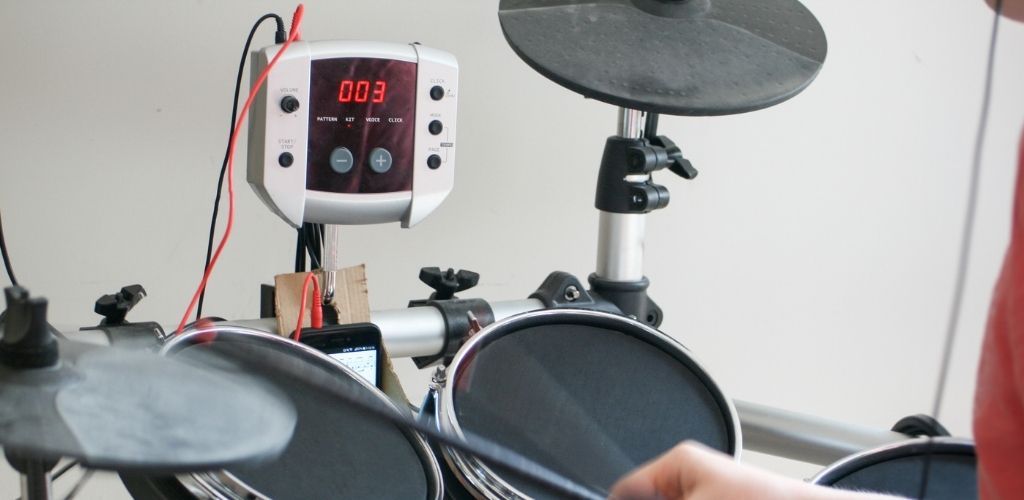
Electronic drums give you a world of volume at your fingertips.
With knobs to twist and buttons to press, you can tiptoe quietly through a late-night practice session.
Your acoustic set, however, isn’t so hush-hush; it’s loud and proud, which is great unless your neighbor’s trying to sleep or you have a soundproof room!
Feel and Response
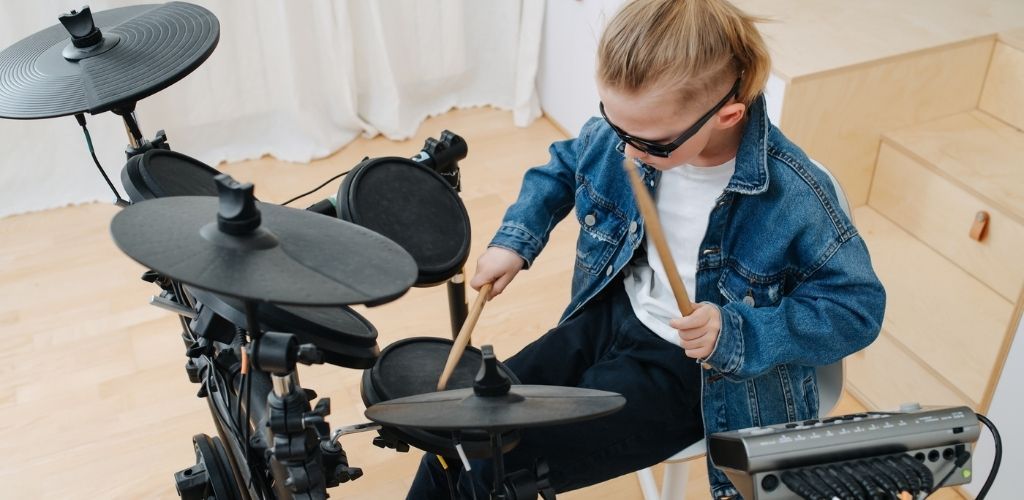
Ah, the feel of acoustic drums, the stick bounce, and the natural vibration—it’s like the drums are talking back!
Electronic drums, though? They’ve come a long way with mesh heads that mimic that acoustic feel, minus the stick-splintering snare hits.
Yet, some say mesh pads and rubber pads still can’t fully capture the soul of a traditional wooden kick.
Practical Differences in Usage

So you’re playing live?
With an acoustic kit, you’re the thunder god of the stage—every hit radiates sheer power. But remember, with electronic drums, you need less muscle and more finesse.
Hybrid kits, though, let’s talk about having your cake and eating it, too, blending electronic sound control with acoustic dynamism.
Considerations for Drummers
When you switch to electronic drums or start your drumming journey with them, there are two key points you really should consider.
The transition isn’t just about adapting and adjusting to new sounds; it also involves redefining your practice routines.
Transition from Acoustic Drum Kit

If you’re a drummer switching to electronic drums, it’s like moving to a new neighborhood—you must get to know the surroundings.
Transitioning requires adapting your playing experience to different drum pad surfaces. Electronic pads can feel less lively than traditional drum skins.
They’re also quieter, so you can jam out without waking up your neighbors or renting a studio.
But remember, the rebound on electronic pads might affect your drum playing technique, especially if you’re used to the acoustic feel.
Skill Building and Techniques

When it comes to building skills, electronic kits can be your personal arcade of drumming with various sounds and tools. It’s like your digital audio workstation!
Using a metronome is a breeze with built-in functions, perfect for keeping your rhythm in check.
And for techniques, practice pads remain your best pal for nailing those ghost notes without relying on volume.
Beginner drummers will find that an electronic kit’s variety of sounds and functions perfectly supports their creative expression.
Yet, mastering drum techniques might take some time without acoustic sets’ noticeable, responsive feel.
Making the Purchase
When it comes to buying an electronic drum set, two critical factors come into play: your budget and the quality of the brand and model you choose.
Let’s make sure you hit the right note with your new purchase!
Price and Budget
When planning your purchase, your budget is your backbone!
Sets range from under $500 for entry-level kits like the Alesis Turbo Mesh to over $2000 for more advanced sets like the Yamaha DTX6K2-X.
Under $500: Ideal for beginners, not feature-rich
$500 – $1000: Mid-range quality, a balance of features and affordability
Over $1000: High-end models, enhanced playability, and durability
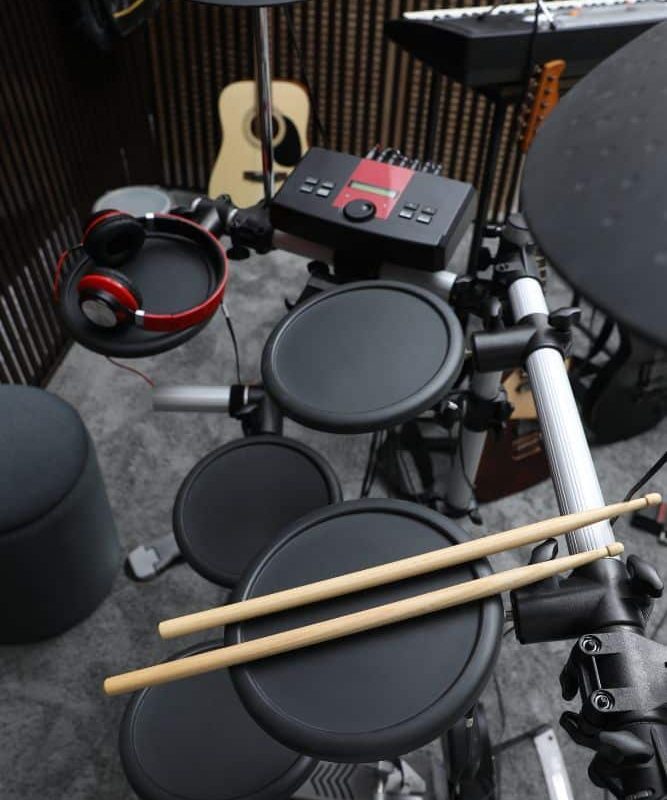
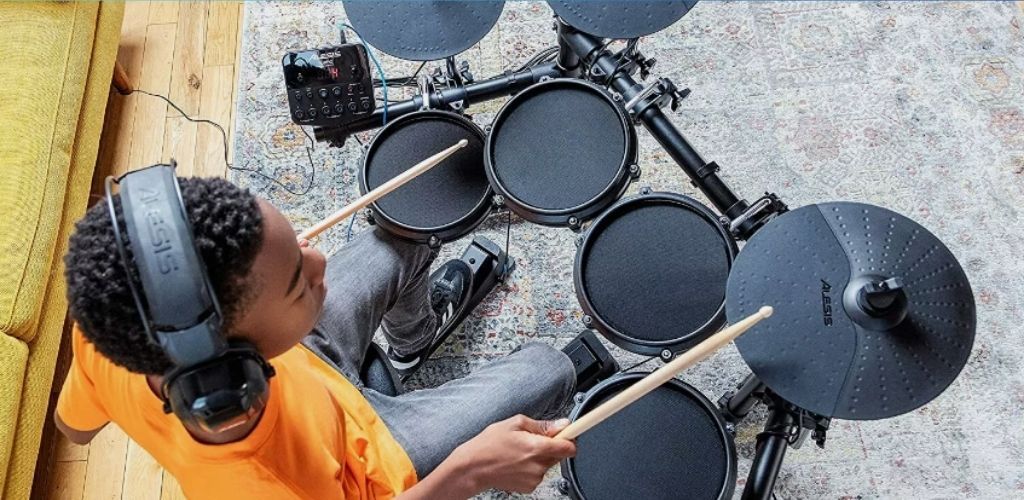
The Alesis Turbo Mesh Electronic Drum Set, with its budget-friendly price and quality mesh heads, gets my recommendation for drummers looking for a cost-effective practice solution without compromising on a realistic drumming experience.
Alesis Turbo Mesh Electronic Drum Set

FEATURES: A complete electronic drum set with mesh heads, MIDI over USB, and integrated practice tools
OTHER INFO: The Turbo Mesh Kit's 8" mesh snare and toms transition naturally
- Lightweight steel rack stand folds for storage
- 10 preset kits: 120 drum, cymbal, and percussion sounds
- Comes with accessories: cables, power supply, drum key, and drumsticks
- No Cons at All!
When you click ‘Check Price’, you’ll see there are loads of great places to buy this item. Our personal favorite is Sweetwater for the US, and Thomann and Gear4Music for the UK & Europe.
They are the largest music retailers, with excellent customer service, competitive prices, really fast shipping, and the longest guarantees.
The professional musician who wrote this article combined many things,
from the product build, manufacturer’s reputation through to feedback
from other users, to create our famous TedScore™.
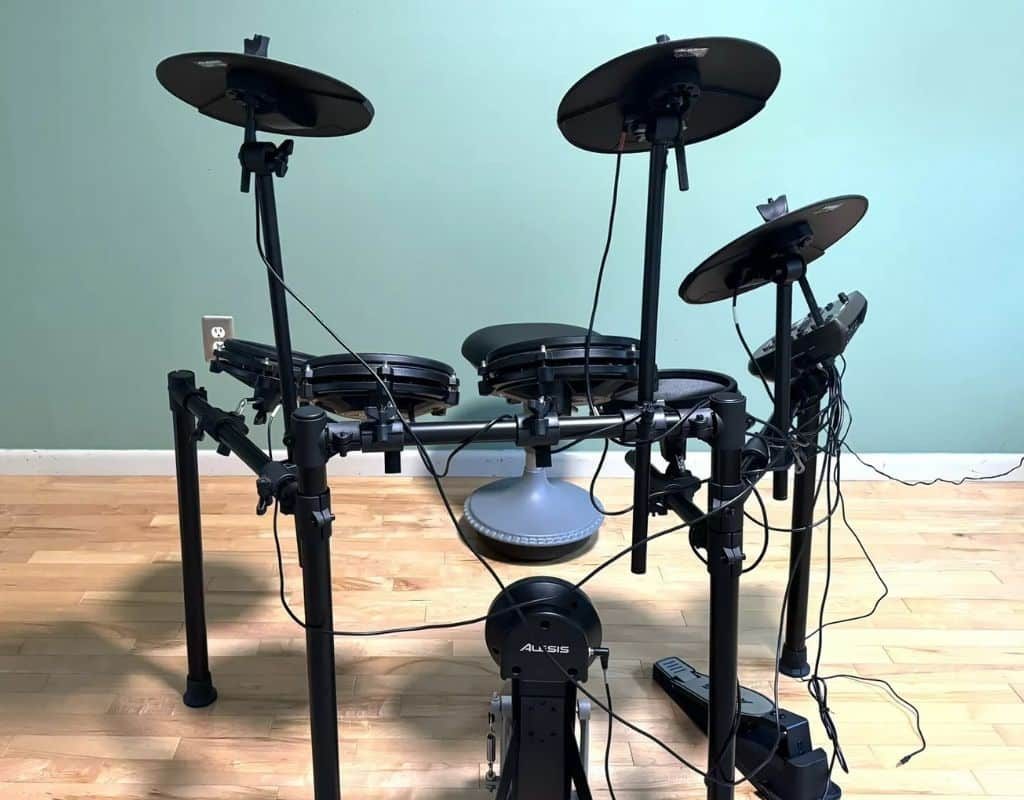
The Alesis Nitro Mesh offers an impressive range of features and responsive mesh heads. I confidently recommend it to my students for its excellent playability and value at an entry-level price point.
Alesis Nitro Mesh
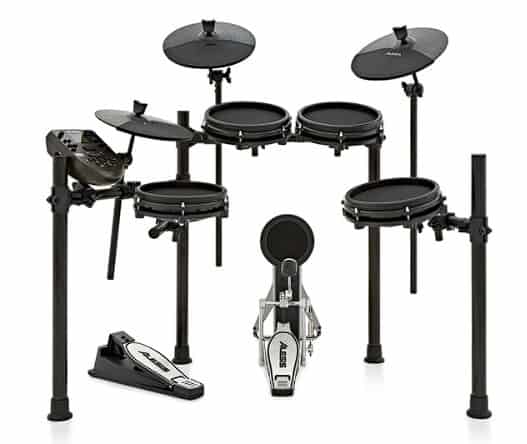
plenty of features
COMES WITH: Complete kit
FEATURES: Dual Zone trigger on the snare
Alesis Nitro Mesh
- 350 built-in sound
- Upgrade options for enhanced performance
- Remote hi-hat pedal
When you click ‘Check Price’, you’ll see there are loads of great places to buy this item. Our personal favorite is Sweetwater for the US, and Thomann and Gear4Music for the UK & Europe.
They are the largest music retailers, with excellent customer service, competitive prices, really fast shipping, and the longest guarantees.
The professional musician who wrote this article combined many things,
from the product build, manufacturer’s reputation through to feedback
from other users, to create our famous TedScore™.
Choosing the
Right Brand and Model

Choosing a drum brand is like finding a trustworthy friend!
You’re spoilt for choice with Roland, Yamaha, and Alesis in the lead. Each brand has its strengths:
Roland: Known for its mesh heads and build quality
Yamaha: Famed for realistic sound and the lauded DTX6K2-X model
Alesis: Offers competitive pricing with a decent performance
Alesis caters well to beginners, while Roland and Yamaha are the go-tos for professionals seeking long-term durability and advanced features.
As a professional, I wholeheartedly recommend the Roland V-Drums TD-27KV2 Electronic Drum Kit for its exceptional sound quality, expressive playability, and advanced features that cater to practicing and performing drummers at any level.
Roland V-Drums TD-27KV2 Electronic Drum Kit

FEATURES: World-class set of pads and a newly enhanced TD-27 sound module
OTHER INFO: Deep editing capabilities allow you to tune, tinker, and tweak every facet of your tone
- Generation Two TD-27 sound module
- Comes with a 14-inch PD-140DS snare drum, 10-inch PDX-100 toms (x3), and 14-inch VH-14D hi-hat
- A bit pricey compared to most electronic kits
When you click ‘Check Price’, you’ll see there are loads of great places to buy this item. Our personal favorite is Sweetwater for the US, and Thomann and Gear4Music for the UK & Europe.
They are the largest music retailers, with excellent customer service, competitive prices, really fast shipping, and the longest guarantees.
The professional musician who wrote this article combined many things,
from the product build, manufacturer’s reputation through to feedback
from other users, to create our famous TedScore™.
Electronic Drums Pros and Cons:
Let's Recap!

Acoustic and electronic drums have their strengths and weaknesses.
To help you recap, don’t forget the following pros and cons of an electronic drum!
- Volume Control: You can turn the volume on electronic drums or use headphones. This means you can rock out without waking the neighbors.
- Portability: They are typically more compact and easier to move than acoustic sets. You can take your beats on the go with less hassle.
- Variety of Sounds: You can switch between different drum sounds and kits with a tap. Imagine having an entire drum store at the tip of your stick!
- Recording Simplicity: Connect to a computer to easily record your sessions. You'll be laying down tracks like a pro in no time.
- Feel: The pads have a different feel from acoustic drums. You might miss the traditional drumhead bounce.
- Dynamics: Capturing the nuances of soft and loud play can be challenging. You may find subtlety is not always the electronic kit's strong suit.
- Cost: Quality electronic drum sets can be expensive, but consider them an investment in your musical journey!
- Repair Complexity: Fixing broken parts on electronic kits can be complex. It's not as simple as replacing a broken drumhead.
By understanding these key points, you can better decide if electronic drums are the right choice for you!
Whether you’re jamming in your apartment or performing on stage, they offer a world of rhythmic possibilities.
Give them a try and see how they amplify your drumming experience!
But Wait! There’s more…
If you want in-depth knowledge and learn who wins the electronic drums vs. acoustic kits battle, this next article is for you!
FAQ's
One disadvantage of an electric drum kit is that it can lack the nuanced dynamic range and authentic feel of an acoustic drum set, potentially leading to a less organic playing experience. Additionally, they require a power source and can be less durable than their acoustic counterparts, with more complex components that may need maintenance or replacement over time.
Electronic drums can be worth it for musicians who value versatility, volume control, and the ability to practice quietly with headphones and those with limited space. They are also beneficial for recording purposes, offering a wide range of sounds and easy connectivity to recording equipment without the need for microphones.
Professional musicians often use electronic drums in live performances and studio settings because they can mimic various percussion sounds, produce modern music, and integrate them with digital audio workstations. They are particularly valued for their versatility in genres like pop and electronic music and any situation where precise sound control is necessary.
Some drummers prefer not to use electronic drum kits because they lack the authentic acoustic feel, classic sound, and full dynamic expression of traditional drums, which is crucial for certain music styles and live performances. Additionally, acoustic drum kits’ tactile feedback and rich tonal qualities are difficult to replicate fully with electronic kits.
Choosing between acoustic and electronic drum pads depends on your needs. If you require natural sound, dynamic range, and the traditional drumming experience, an acoustic drum is preferable; however, if you need volume control, space-saving options, and a variety of programmable sound effects, electronic sets might be the better choice. Consider your playing environment, the genres you play, and whether you’ll be recording or performing live to make the best decision for your situation.










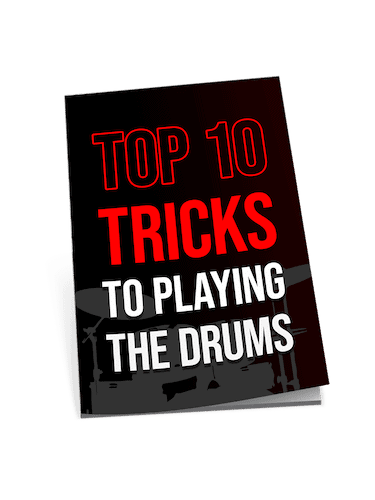
In terms of connectivity and flexibility, electronic drum kits certainly have an advantage, offering USB, MIDI, and even Bluetooth options for interfacing with software and hardware. Additionally, the ability to control volume and use headphones makes it an ideal choice for apartment dwellers or late-night practice sessions. However, it’s crucial to note that while electronic kits have come a long way in simulating the feel and response of acoustic drums, there remains a discernible difference that can affect a drummer’s dynamics and expressiveness. This is particularly evident in the transition from an acoustic snare to a rubber or mesh electronic pad.
ok i gotta say, no electronic drum can match the vibe of an acoustic kit. it’s like comparing vinyl to digital music. there’s a warmth and a punch you get from acoustic that electronics just miss. anyone else feel this or am I on my own here?
can these electronic drums work without electricity? just asking for a friend lol
Erm, no!
Oh great, another thing to make everything more digital. Miss the days when music felt real, you know? But sure, let’s go ahead and hit plastic thinking it’s the same.
Hey, I get the love for vintage, but don’t knock it till you’ve tried it. Some of these kits can produce sounds you’d swear were from an old-school drum. It’s all about how you use them.
I’m considering an electronic drum kit for my son, but I’m concerned about the feel compared to acoustic drums. Does it provide a realistic drumming experience?
A realistic drumming experience? Yes. But it is a DIFFERENT drumming experience… It’s not right or wrong…
Gotta say, electronic drum kits have come a long way. The variety of sounds and kits you can get out of just one set is pretty amazing. Just read Sam’s breakdown, and it’s spot on. The only thing is, you need to spend a bit to get a kit that doesn’t feel too synthetic. But once you do, it’s game-changing, especially for recording.
Hey Sam, quick one for ya – does the article dive into how electronic kits can help with learning new styles or techniques? Thinking of shifting from acoustic and curious about the transition phase. Thanks!
It doesn’t go deep into that, nope. Sorry!
Following this, also thinking of getting one. Sounds promising.
AlexR92, electronic kits are super versatile for learning. You’ll love the range it offers for practice!
Hey, just wondring if anyone thinks that transition from an acoustic to an electric drum kit loses any of that authentic drum feel? Can electronic kits really mimic that well? Not sure if Sam touched on this in depth or not. Thx.
It’s a different feel, that’s for sure. But that doesn’t mean it’s wrong…